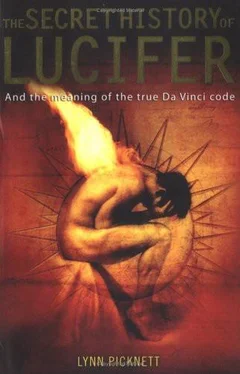The last sentence - as several libertine Gnostic sects firmly believed - seems implicitly to approve of those who have a great deal to forgive, such as the unnamed woman who `loved much'. The greater the sins, the greater the forgiveness. But why should Luke fight shy of giving any details that would link the milestone event of the anointing with the Magdalene or indeed the last and climactic part of Jesus' mission? And why does he insist on calling it `a certain village?' The other gospel writers obviously knew it was Bethany, so presumably so must Luke, although he did everything he could short of excluding the episode completely to obscure the fact. Why?
Some scholars, such as Hugh J. Schonfield, admit that there was something about Bethany and the family whom Jesus visited there that appears to be deliberately withheld by the Gospel writers. Yet this seems odd, for the `Bethany family' actually make the necessary arrangements - to put it more cynically, stagemanage - the lead-up to the crucifixion. For example, as Schonfield points out in his closely argued The Passover Plot (1965), they are the key characters who provide the donkey on which Christ rides triumphantly into Jerusalem, apparently deliberately ensuring that the Old Testament prophecies about the Messiah are fulfilled. However, if that was their raison d'etre, the ensuing arrest, torture and crucifixion of Jesus must have come as a traumatic shock, for the Jewish Messiah was never expected to die - at least not before liberating his people from the occupying Romans. And he emphatically was not supposed to suffer the shameful death of a common criminal, nailed to a cross in a public place, reviled and spat at by the dregs of society.
But whatever the underlying motivation behind the Bethany family's involvement in the furthering of the mission, there was another link that may explain why Luke avoided mentioning the village by name, and why the disciples generally felt a great distaste for it and everything it stood for. And this also provides a major link with the real `Da Vinci code' and a crucial `Luciferan' current that drove many heretics, even up until the present day.
Leonardo's legacy
Christians might be horrified to learn of the true extent of heresy that my colleague Clive Prince and I have discovered in the allegedly `pious' paintings of Leonardo da Vinci. First, there was a giant `M' shape in the painting of The Last Supper, created by the figures of Jesus and the `Beloved', indicating that `he' is actually a she: none other than Mary Magdalene.
Then there is a distinctly homoerotic undertone in his St John the Baptist, one of only two of his works which had pride of place in the room where he died in 1519 - the other being the Mona Lisa.
The peculiar St John is not well liked among art historians, and one can easily see why. The young man leers knowingly at the observer, a pretty boy with luxuriant curls and fur hanging negligently off one polished shoulder, apparently the keeper of deep and probably dark secrets - judging from his wicked smile, a knowledge as old as sin. (A considerably less well-known work, a sketch of Bacchus, is unambiguously phallocentric: another young man smirks at the observer, but he is naked, his phallus unavoidably - and impressively - aroused. As we have seen, Bacchus was associated with Dionysus and Pan, gods of the wild woods and shameless sex rites, and in Leonardo's more finished depiction of this pagan deity the resemblance to his John the Baptist is striking. Indeed, both may have been based on the artist himself as a young man: Leonardo loved including himself in his own works.)
St John the Baptist almost appears to be `camping it up', while raising his right index finger across his body to heaven, in what Clive and myself had dubbed `the John gesture'. Although this appears in many medieval and Renaissance works to indicate the significance of heaven or generally the `higher things' of spirituality, in Leonardo's works it always indicates, or is actually made by, John the Baptist - whom he clearly appears to revere intensely. Leonardo's devotion to the Baptist is promoted through sly allusions and half-hidden symbols, even at the expense of the Holy Family. . Although Clive and I have detailed Leonardo's heretical - `Johannite' - symbolism elsewhere," I shall provide a summary here to illustrate my argument.
In The Last Supper a disciple is thrusting a finger raised in the unmistakable `John gesture' into Jesus' face with a rough intensity, although Christ ignores him and stares serenely down at his outspread hands - between which there is no chalice of wine, as one might expect, no `Holy Grail'. What does the gesture mean here? Is it, as Clive and I suggest, a terse and even hostile `Remember John ...'? But why should Jesus need reminding of his forerunner, the wild man from the desert - his cousin - who apparently fell down at his feet and declared him to be `the Lamb of God'? And why is there the implicit warning in the gesture? Should you think that we are reading too much into this, our examination of Leonardo's other works proved surprising, even shocking.
The `Cartoon' (or preliminary drawing) of the Virgin and Child with St Anne and John the Baptist, which is now displayed in London's National Gallery" shows an apparently masculine St Anne raising a massive John gesture at her daughter, the Virgin, who smiles slightly, totally oblivious. (It has been suggested that St Anne is really intended to depict St Elizabeth, the Baptist's mother.) The young St John gazes up without expression at the baby Jesus, who seems almost to writhe forward in his mother's arms, in order, apparently, to bless him. Yet the infant Christ has a strangely serpentine or maggot-like body (complete with sectioned torso) and appears to be an extension of his mother's arm, almost like a glove puppet. And although supposedly chucking John under the chin with one hand while blessing him with the other, it takes no stretch of imagination to notice that the one hand could equally well be steadying the boy's head to take a blow. To those who are impatient with this sort of heretical interpretation, may I advise caution, an open mind, and an open book - as large as possible - of Leonardo reproductions. It is surprising what the `uneducated', non-art historian will find - such as the following, a new revelation.
With a mind cleared as far as possible of preconceptions, look with a child's unsophisticated clarity at the Cartoon, specifically at the tree-covered hill in the top right-hand corner, above John's curly head. Actually, the `hill' serves a double purpose, for its elaborate foliage also forms the distinct outline of the severed head of a bearded man, with closed eyes. (Once seen, he can never be unseen: some friends admit that they continually expect the man in their reproduction suddenly to open his eyes any day now.) Why would Leonardo depict a severed head? A clue lies in its position over young John - according to the biblical account, John the Baptist was beheaded while in King Herod's jail. He had been arrested for denouncing the Roman puppet's illegal marriage, and suffered death because Herod's wife Herodias had persuaded her daughter - who remains anonymous in the New Testament - to ask the king for John's head.
The astonishing, half-hidden theme of the Cartoon is also played out in Leonardo's other works, as we shall see - even in the finished painting based on the Cartoon, although the hovering head disappears in the transition. Even a cursory glance reveals that The Virgin and Child with St Anne has changed considerably since its haunting preliminary sketch was created. Mary is still sitting somewhat awkwardly on her mother's lap, but John the Baptist has completely disappeared, to be replaced by a lamb. Yet in the New Testament it is Jesus, not John, who is symbolized by the Lamb, and it is the Baptist who memorably hails him as such. In Leonardo's painting the lamb seems in imminent danger, for baby Jesus boisterously hangs on to its ears - almost as if intent on pulling its head off - while a chubby limb cuts across the lamb's neck, creating the visual illusion of decapitation. But why would Jesus at any point in his life want to harm the saint who proclaimed his divinity to the world?
Читать дальше












